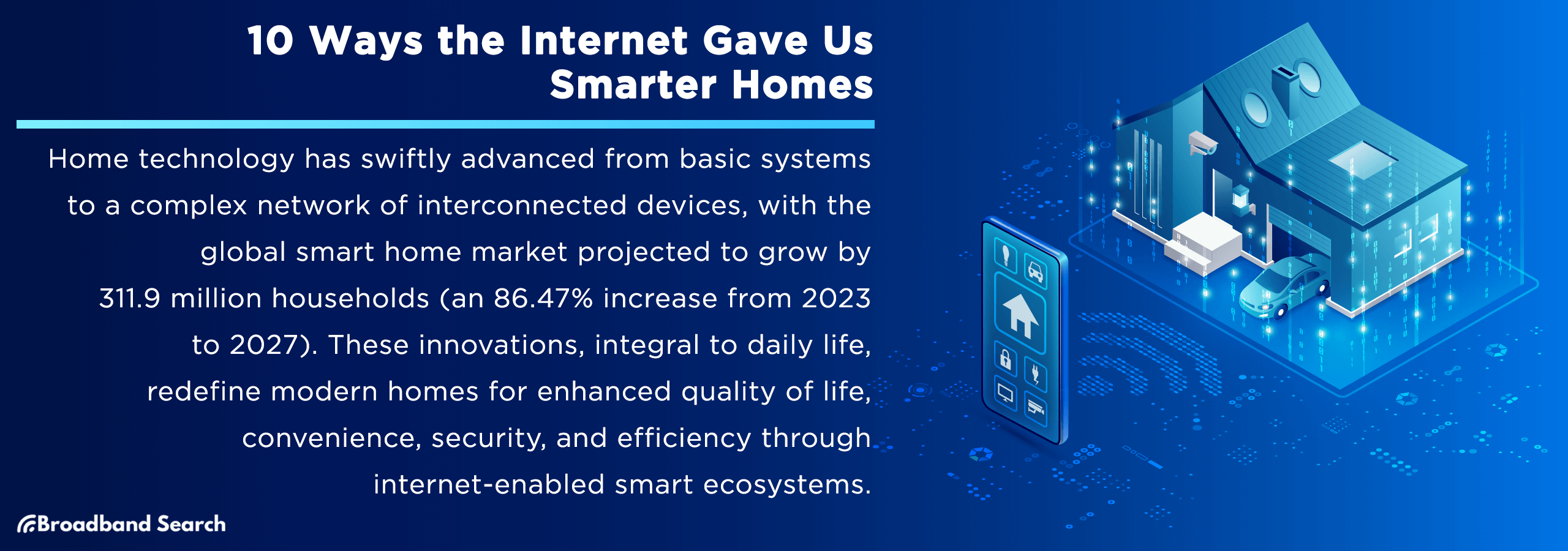The evolution of home technology has witnessed a profound metamorphosis over the past several decades. What began as rudimentary systems for comfort or security—think bulky air conditioning units or simple home alarms—has since morphed into an intricate web of interconnected devices and platforms. In fact, the global number of users in the smart home market is set to surge continuously between 2023 and 2027 by 311.9 million households, marking an increase of 86.47 percent. These innovations, designed to optimize our living spaces, no longer merely add convenience; they are integral parts of our daily lives, seamlessly woven into the fabric of our modern homes.
Central to this transformation has been the ubiquity and exponential growth of the internet. Before its widespread adoption, homes functioned in isolated capacities, with each device and system operating independently. The internet changed this paradigm entirely, allowing devices to communicate with each other and with their owners in previously unimaginable ways. As a result, traditional homes began to evolve, transitioning from simple brick-and-mortar dwellings to integrated, intelligent ecosystems. These "smart homes" leverage the power of the internet to enhance our quality of life, redefine convenience, and provide unprecedented levels of security and efficiency.
Historical Context
- 1968-1969: The dawn of home automation began with the ECHO IV, a device developed by Jim Sutherland for basic home management tasks, though it never saw commercial light. This era also introduced the Kitchen Computer for recipe storage, and the inception of ARPANet, a cornerstone for future internet development.
- 1971: The microcontroller era made technology more accessible and affordable. This era marked the increasing ubiquity of electronic gadgets in households.
- 1975: Home automation took a leap forward with the X10 Home Automation Project, using a home's inherent AC wiring to control appliances and lighting.
- 1984: The American Association of House Builders introduced the world to the term "Smart Home," a concept that felt like it was straight out of a sci-fi novel.
- 1991: The onset of "Gerontechnology" combined technology with gerontology, focusing on enhancing the quality of life for senior citizens.
- 1996: The era brought forth The Clapper, a device activated by sound, making it a hallmark of 20th-century home automation innovations.
- 1998: The "Millennium House" in the UK showcased the vast potential of home automation, with features like automated lighting, security, and heating systems.
- 1999: Kevin Ashton, a computer scientist, coined the term 'Internet of Things' during his tenure at Procter & Gamble. He envisioned embedding RFID chips on products for efficient tracking throughout supply chains.
- Late 1990s - Early 2000s: The rise of the internet saw a surge in home automation popularity. "Domotics" became a household term, signifying the increasing interconnection of household appliances.
- 2014: Amazon's Echo made its debut, solidifying Alexa's position as a pioneering force in smart home hubs, especially with 1.5 million automated systems already in place by then.
- Today and Beyond: Smart technology's pervasiveness promises unparalleled convenience, security, and energy efficiency. With emerging automation trends, homeowners can look forward to increased interactivity, enhanced connectivity, and an overall enriched living experience.
Pros and Cons of a Smarter Home
In the evolving landscape of the 21st century, the concept of a 'home' has transformed significantly. No longer just a place of shelter and comfort, today's homes are brimming with technological advancements that promise heightened convenience, security, and efficiency. This evolution towards 'smarter homes' integrates the realms of digital innovation and domestic life. While the allure of controlling one's environment with a mere touch or voice command is undeniable, it's crucial to understand that the journey of smart homes isn't without its bumps. As we stand on the cusp of this revolution, it's essential to delve into both the advantages and potential pitfalls of embracing a smarter home.
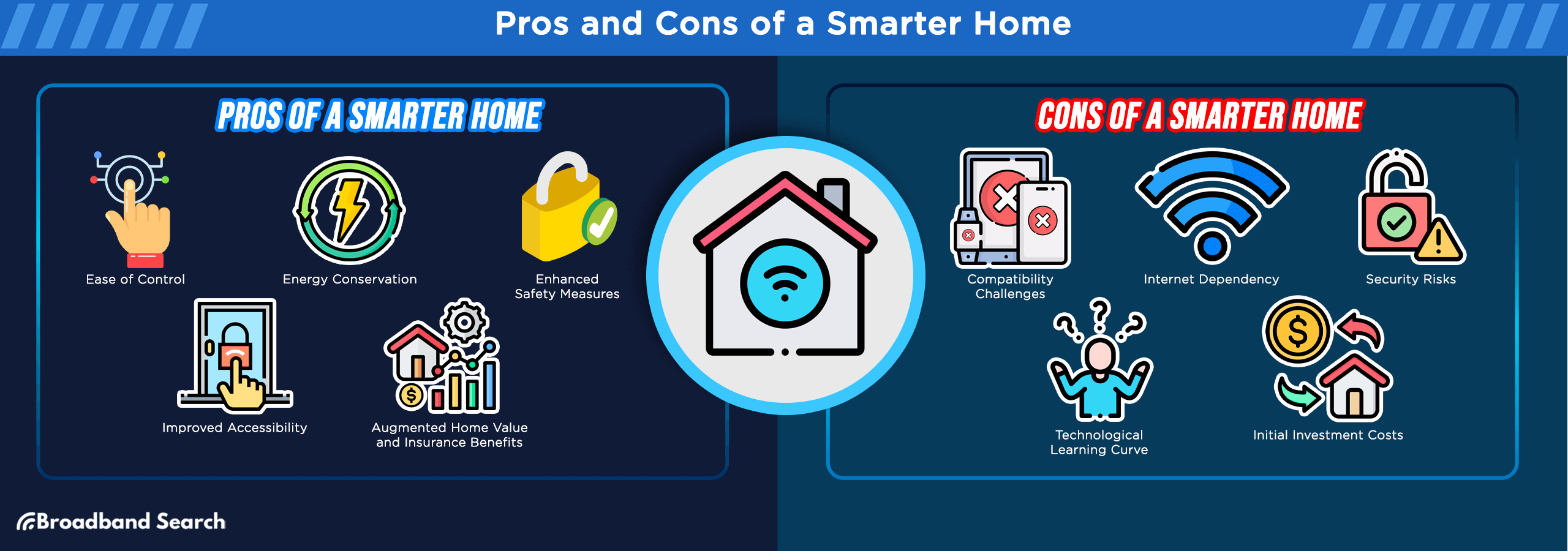
Pros
- Ease of Control: One of the primary benefits of smart homes is the centralized control they offer. Whether it's adjusting the thermostat, turning off lights, or checking security cameras, homeowners can manage multiple functions through a single device or application.
- Energy Conservation: Smart devices like thermostats and lighting systems can adapt to your habits, ensuring optimal energy usage. This not only reduces the carbon footprint but also translates to significant savings on utility bills.
- Enhanced Safety Measures: Smart security systems, from doorbell cameras to motion sensors, provide homeowners with real-time alerts and surveillance, ensuring that their property and loved ones remain protected.
- Improved Accessibility: For the elderly or those with disabilities, smart homes can be life-changing. Voice-activated systems, automated door openers, and other such features can make daily tasks more manageable.
- Augmented Home Value and Insurance Benefits: A fully integrated smart home can significantly increase property value. Additionally, some insurance providers offer discounts for homes equipped with advanced security and monitoring systems.
Cons
- Compatibility Challenges: Not all smart devices communicate seamlessly with each other. This can lead to compatibility issues, requiring additional interfaces or even replacements to ensure smooth operation.
- Internet Dependency: Most smart home systems rely heavily on internet connectivity. A disruption in internet service can render many of these systems inoperative.
- Security Risks: While smart homes enhance physical security, they also introduce cybersecurity threats. Hackers can potentially access personal data or even manipulate home systems if they're not secured properly.
- Technological Learning Curve: For those not tech-savvy, setting up and managing smart home systems can be overwhelming. It requires a certain level of familiarity with technology and may demand regular updates.
- Initial Investment Costs: Setting up a smart home requires a significant initial investment. High-quality devices and the necessary infrastructure can be expensive, and while they offer long-term benefits, the upfront costs can be a deterrent for some.
10 Ways the Internet Enabled Smarter Homes
Looking back in the days, homes were simple refuges from the outside world, places where comfort was derived from basic amenities and family connections. Yet, with the meteoric rise of the internet, these humble abodes have been catapulted into the future. Today, they stand as intelligent entities, blending tradition with technological advancements. These ten transformative ways the internet has redefined our living spaces, crafting a nexus between age-old domesticity and modern-day innovation.
Smart Thermostats
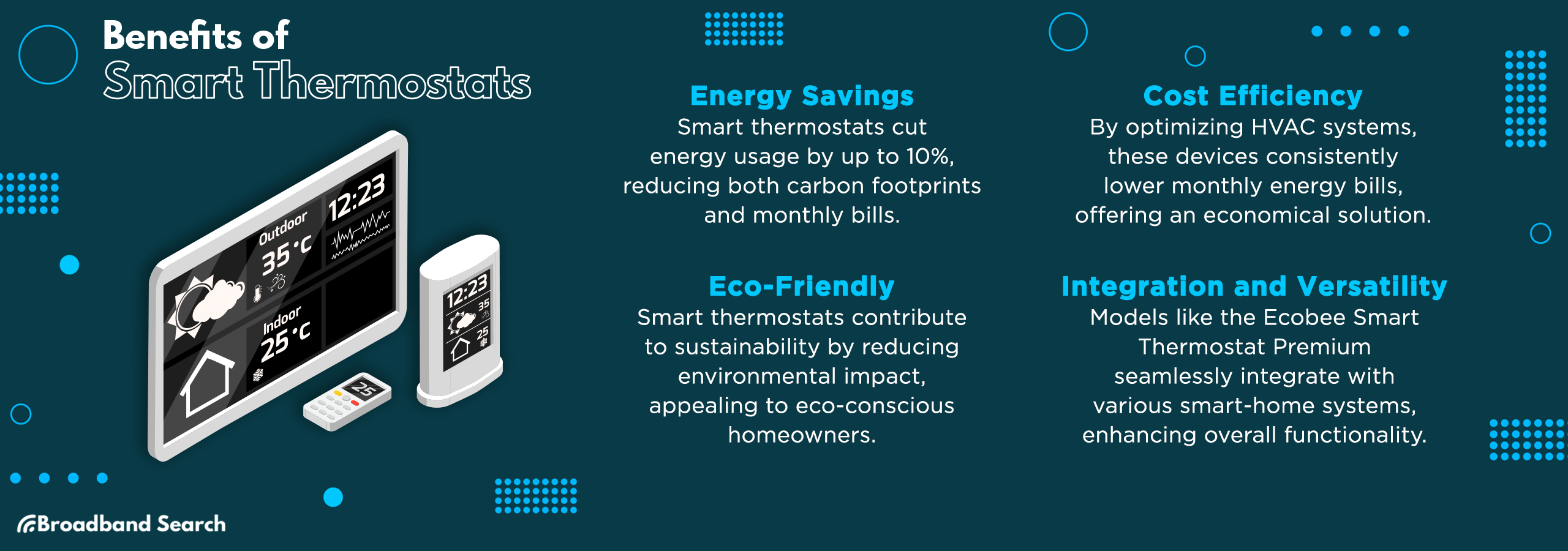
Smart thermostats have emerged as game-changers, offering homeowners unparalleled control over their indoor environments. The American Council for an Energy-Efficient Economy's 2018 report underscores this shift, indicating that HVAC-connected smart thermostats can contribute to energy savings of up to 10%. This not only translates to reduced carbon footprints but also tangible reductions in monthly energy bills, making them a favorite among eco-conscious and budget-aware individuals.
The market's enthusiastic reception of smart thermostats is further evidenced by its robust growth. Data from NMSC reveals that the global smart thermostat market, which stood at a noteworthy 2.6 billion U.S. dollars in 2021, is on an upward trajectory. Predictions suggest a nearly tenfold growth, with the market potentially reaching a value of 25.5 billion U.S. dollars by 2030. This meteoric rise reflects the increasing trust and value homeowners place on these adaptive, intelligent devices in their quest for smarter living.
Popular Smart Thermostat Models
- Ecobee Smart Thermostat Premium: Standing out in performance, Ecobee's premium model has surpassed its competitors, boasting the most effective remote sensor we've come across. Not only does it feature an air quality monitor, but it's also equipped with a built-in microphone, speaker, and Alexa compatibility for voice commands. Additionally, its adaptability shines as it integrates smoothly with a majority of smart-home systems.
- Amazon Smart Thermostat: Exclusively compatible with Alexa, this thermostat leverages Alexa Hunches to maintain an ideal room temperature. Its sleek design, combined with its affordability (priced under $100), makes it a notable choice for smart homeowners.
- Nest Learning Thermostat: With a nod to traditional thermostats through its rounded design, this device merges nostalgia with contemporary aesthetics, effortlessly complementing various home interiors.
Home Security Systems
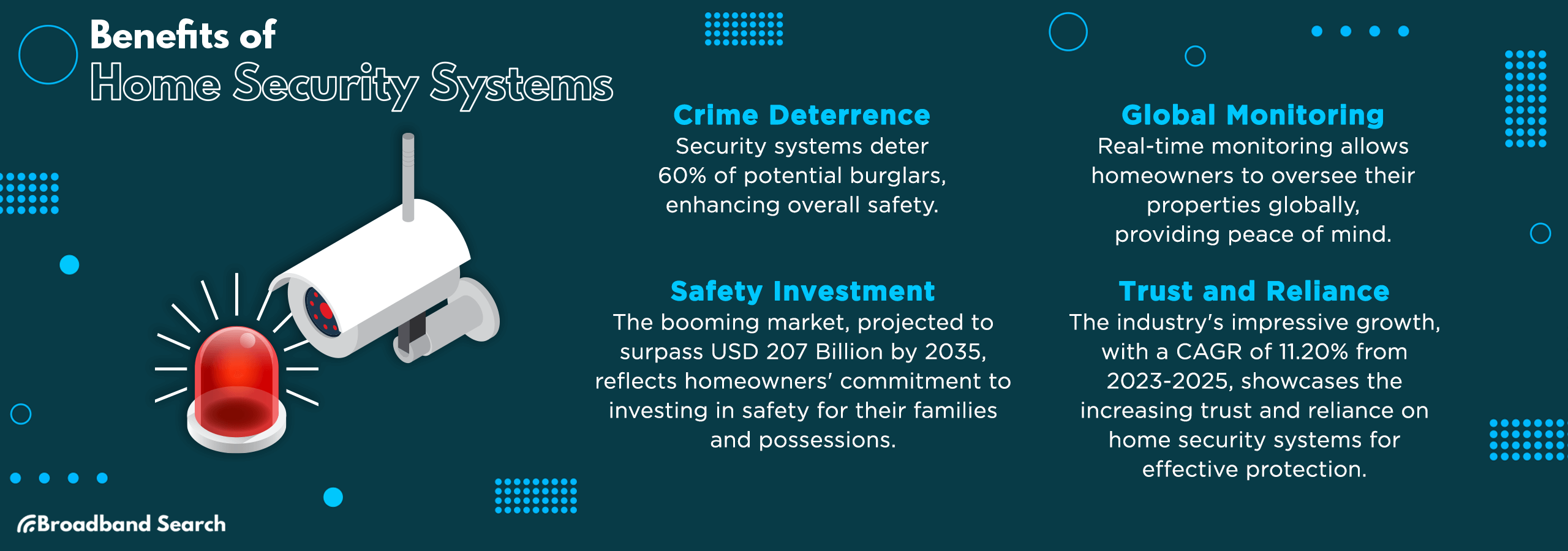
Safety and security is a paramount concern for homeowners, guiding both decisions and investments to ensure the well-being of their families and cherished possessions. The burgeoning market for advanced home security systems, supported by cutting-edge technological innovations, stands as a testament to this priority. The metrics are clear: the global home security systems market is projected to eclipse USD 207 Billion by 2035, with a CAGR of 11.20% during 2023-2025. This impressive trajectory, surging from an industry valuation of over USD 58 Billion in 2022, underscores the burgeoning trust and reliance on these protective solutions.
A notable facet fueling the adoption of smart security is its tangible impact on crime rates. Research underscores the preventative impact of security systems: a significant 60% of burglars, while evaluating potential targets, are dissuaded simply by the presence of an alarm system. This statistic, coupled with real-time monitoring capabilities, ensures homeowners can vigilantly oversee their properties from any corner of the globe. Not only do these systems act as potent crime deterrents, but they also empower homeowners, ensuring peace of mind in an increasingly interconnected world.
Global Smart Home Security Adoption Rates by Country in 2026
The penetration of smart home security systems has been gaining momentum across the globe, reflecting a growing emphasis on safety and the benefits of technological integration in daily life.
- South Korea - 60.9
- Norway - 59.2
- Netherlands - 47
- United Kingdom - 45.2
- United States - 42.5
- Switzerland - 37.9
- Germany - 37.6
- France - 32.8
- Sweden - 28.5
- China - 23.9
Smart Lighting
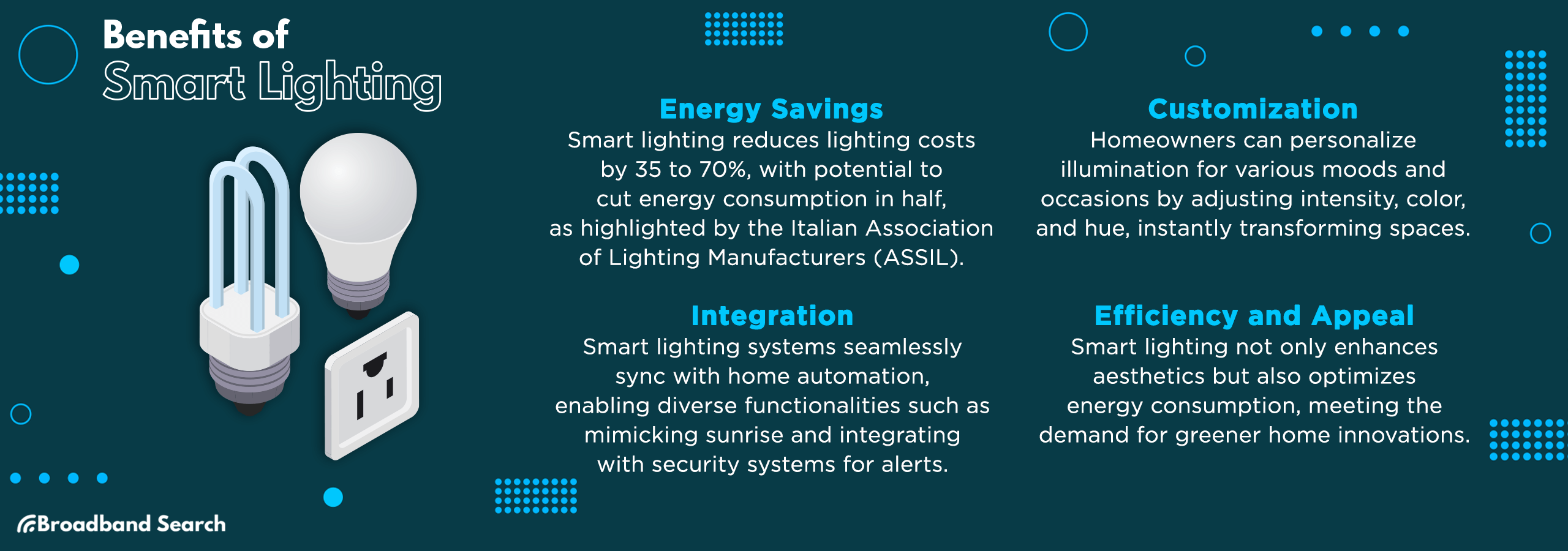
Intelligent illumination is not just about setting the right mood or enhancing the aesthetic appeal of spaces; it's also about making energy consumption smarter and more efficient. Energy savings ranging from 35 to 70 percent on overall lighting costs demonstrate the compelling potential of smart lighting solutions. ASSIL, the Italian Association of Lighting Manufacturers, further bolsters this claim, pointing out that the incorporation of intelligent lighting can slash energy consumption by half. A crucial metric to gauge these savings is the lumen/watt ratio, which offers insights into the efficacy and efficiency of lighting systems.
The benefits of smart lighting extend well beyond just energy conservation. It offers homeowners the ability to customize illumination based on personal preferences or specific occasions, allowing for mood setting and ambiance creation. The capability to adjust light intensity, color temperature, or even hue can transform any space instantly. Moreover, smart lighting systems can seamlessly integrate with other home automation systems, offering synchronized functionality. Whether it's setting lights to mimic sunrise in the morning or integrating with security systems for alert signals, the possibilities are both vast and exciting. As technology advances, the push for greener solutions and the allure of personalized environments ensure that smart lighting remains at the forefront of home innovations.
Voice Assistants & Smart Speakers

In 2022, voice-activated technologies saw significant integration into daily routines, with 57% of voice command users employing these commands daily. A shift in audio consumption patterns was evident, with 20% of smart speaker owners primarily using these devices for listening, up from 18% in 2017. Moreover, 62% of Americans aged 18 and above utilized voice assistants across diverse devices, from smartphones and smart speakers to in-car systems and TV remotes, highlighting the pervasive presence and importance of voice-activated tools in contemporary lifestyles.
Leading Brands and Models
- Amazon Echo (4th Gen): Rated 8/10 by WIRED, this sphere-shaped Amazon Echo offers robust bass and a wide soundstage. It delivers 360-degree, room-filling sound, ideal for any space including kitchens and smaller living rooms.
- Google Nest Audio: Google's Nest Audio, scoring 8/10 from WIRED, presents as Echo's primary competitor. Its cushion-like design produces powerful sound for small to medium rooms. When paired, two units provide a standout stereo experience at a $200 price range.
- Sonos Roam: The portable Sonos Roam is compact and lightweight, perfect for mobility. Designed for outdoor use with an IP67 dust and water resistance rating, it ensures over five hours of playback on a single charge.
Evolution and Future Projections
- Voice Push Notifications: Voice notifications are on the rise, with 55%-60% of users opting in. Businesses can send timely messages through platforms like Google and Alexa, which connect to third-party apps, facilitating diverse notifications from reminders to music alerts.
- Inbuilt Security Features for Users: Security in voice assistants is becoming paramount. Companies like Amazon and Google are introducing features like speaker verification and ID confirmation. Amazon has detailed Echo's data protection measures, ensuring users that personal data isn't stored.
- Inbound Calls and Smart IVR with NLU: Advanced IVRs with Natural Language Understanding enhance sales and customer relations. Virtual agents, powered by NLP, answer queries in real-time. Integrated call tracking offers comprehensive monitoring and data collection for future outreach.
Smart Appliances
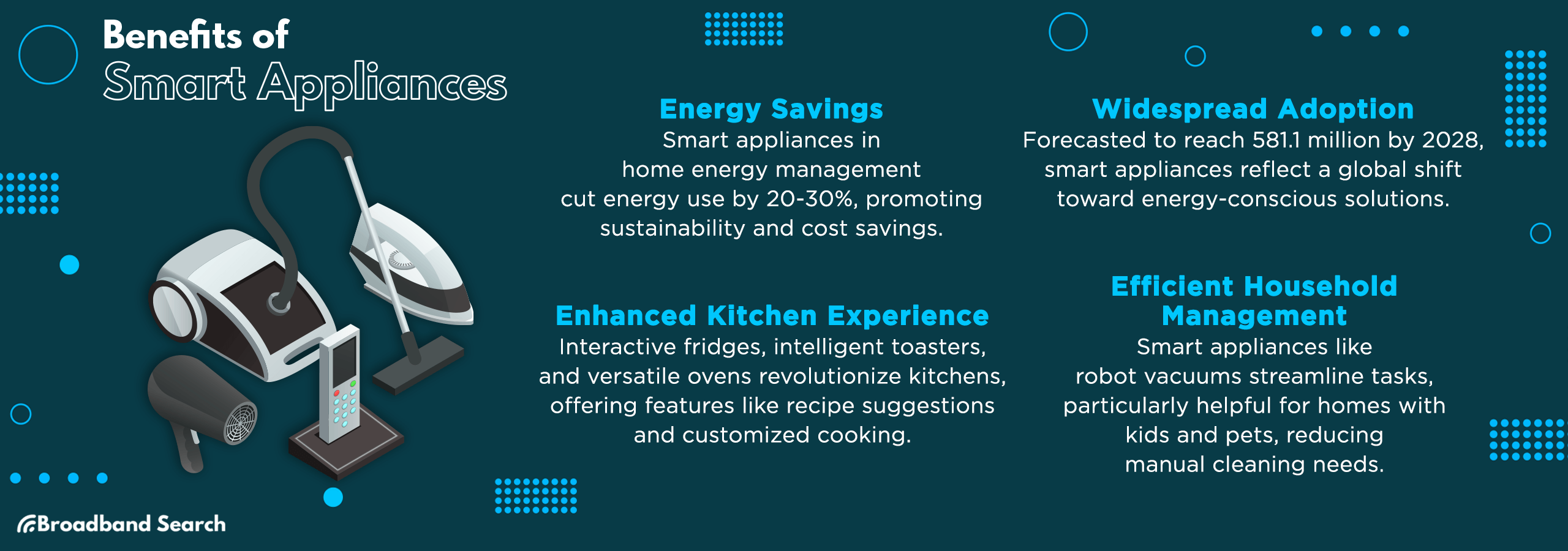
Home energy management systems, alongside commercial building counterparts, integrate state-of-the-art equipment, automated appliances, sensors, controls, and software. These components harmoniously work together, granting users the ability to seamlessly monitor and regulate their energy usage. By retrofitting these systems with efficient appliances, homeowners and businesses can unlock significant energy savings, with reductions ranging from 20% to 30%.
The appeal of smart appliances is undeniable. Forecasts indicate a burgeoning adoption rate, with the number of active households utilizing smart appliances expected to soar to a staggering 581.1 million by 2028. As the world gravitates towards energy-conscious solutions, these appliances not only present a path to sustainability but also serve as a testament to the future of home and commercial energy management.
Examples of Leading Smart Appliances
- Interactive Smart Fridge: While the essence of refrigerators hasn't undergone dramatic transformations over the years, the introduction of smart fridges is revolutionizing the space. These modern marvels can offer recipe suggestions, narrate cooking steps, curate and display grocery lists on their sleek doors, and even synchronize the list with your smartphone. Moreover, they're proactive – alerting you about potential spoilage of stored items.
- Intelligent Rapid Toasters: The notion of a toaster has transcended merely browning your bread. Some cutting-edge toasters can etch designs onto your morning slice, showcasing how traditional toasters were truly limiting our imagination. These innovative devices cater to diverse bread types, adapting temperatures, toasting speeds, and custom preferences – it's like having a toaster that truly knows you.
- Versatile Smart Oven: Forget the conventional oven understanding; the latest smart ovens are multifunctional powerhouses. They synchronize with recipes, ensuring optimal preheating and timely shut-offs. Their adaptability is noteworthy, offering steam for moisture-intensive dishes like the popular pandemic sourdough or enhanced air circulation for perfect pastries.
- Robot Vacuum: Among the standouts in smart appliance innovation is the robot vacuum. While we might be slightly biased, there's a strong case for integrating robot devices into a contemporary household. For homes bustling with kids and pets, these devices are a boon, diligently navigating tight spots and reducing the frequency of manual cleaning sessions.
Health and Wellness Tech
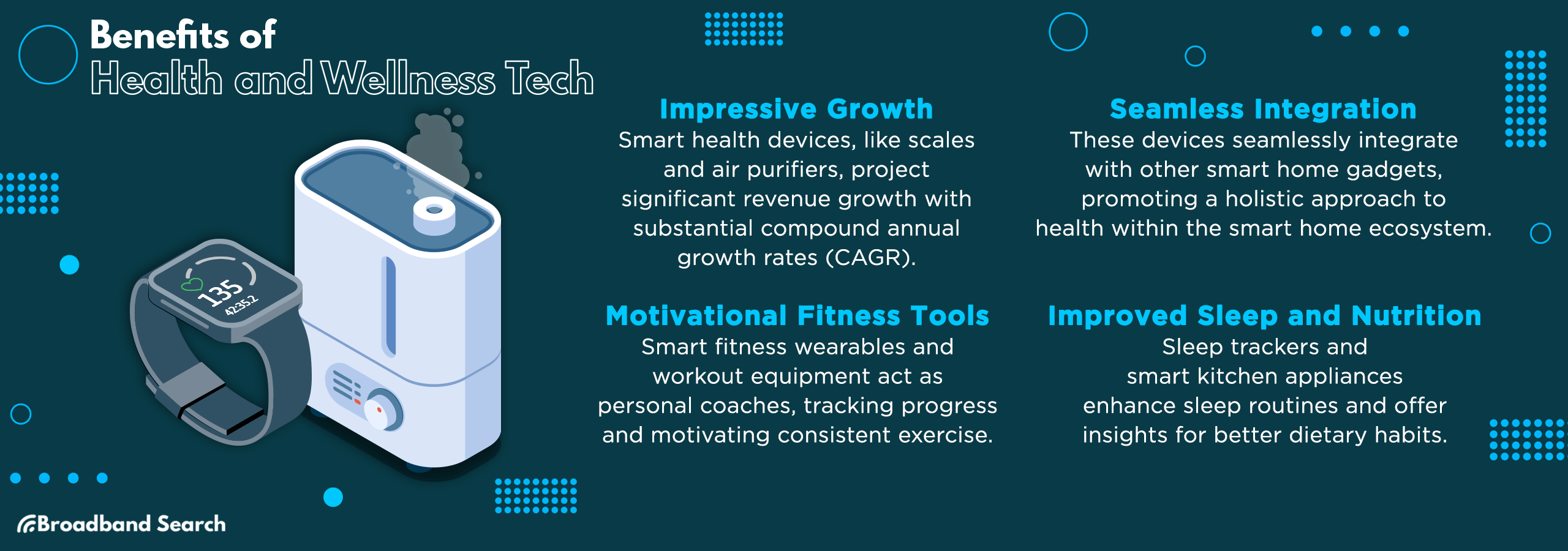
In the realm of health and wellness, the incorporation of smart technology has led to a surge in demand and impressive projected growth for several key products. Smart scales, for instance, are seeing steady growth with revenue anticipated to reach US$4.97 billion by 2028, reflecting a CAGR of 6.96% between 2023 and 2028. Meanwhile, the air purifier market, influenced by increasing airborne infections and urban pollution, was valued at USD 13.97 billion in 2022 and expects a 7.3% CAGR until 2030. In a similar trajectory, the global smart fitness market, encompassing innovative equipment and wearables, stood at US$ 13,122.3 million in 2022 and is forecasted to ascend to a staggering US$ 46,934.8 million by 2033, marking a CAGR of 12.4%.
As these smart health devices gain traction, their interconnectivity with other smart home gadgets is becoming an invaluable feature. Whether it's smart scales integrating with fitness apps to track progress or air purifiers syncing with home automation systems to ensure optimal air quality, the seamless interaction of these devices not only enhances user experience but also ensures a holistic approach to health and well-being in the smart home ecosystem.
Impact on Health and Lifestyle
Smart devices have remarkably reshaped our health and lifestyle choices, directly influencing our day-to-day routines:
- Increase Motivation to Exercise: With smart fitness wearables and interactive workout equipment, it's easier than ever to track progress, set goals, and receive feedback. These features act as a personal coach, urging individuals to remain consistent and pushing them to surpass their previous benchmarks.
- Get More Sleep: Sleep trackers and smart beds provide insights into sleep patterns, emphasizing the importance of a restful night. Through analysis and feedback, individuals are nudged to modify habits that disrupt sleep, fostering a healthier sleep routine.
- Eat Better: Smart kitchen appliances can recommend healthier recipes, measure calorie intake, and even help manage portion sizes. In combination with nutrition tracker apps, individuals get a clearer picture of their dietary habits and areas of improvement.
- Helps Track Our Nutrition and Fitness: Integrated health platforms combine data from various devices like smart scales, wearables, and nutrition apps. This holistic overview enables individuals to understand the synergy between diet and exercise, ensuring a more informed approach to well-being.
Integrated Home Automation Systems
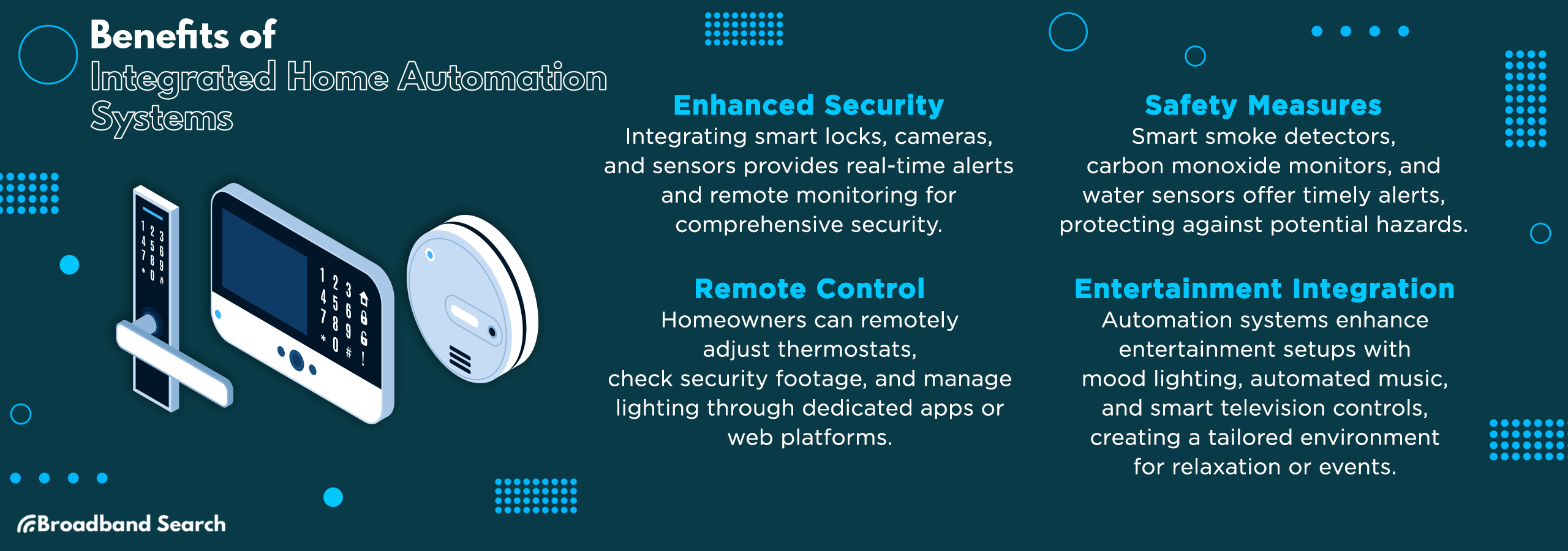
The accessibility to control your home from anywhere has revolutionized the way homeowners interact with their living spaces. In 2022, the value of this change became evident as the home automation market reported an impressive revenue of US$ 45.6 Billion. With technological leaps expected to continue driving the sector, forecasts suggest that by 2033, the market could burgeon to an astounding US$ 136.5 billion. This growth trajectory, marked by a projected CAGR of 10.6% from 2023 to 2033, underscores the rising allure and adoption of these integrated systems.
Integral to the appeal of these home automation systems is the harmonious collaboration of individual devices. Today's systems transcend the capabilities of standalone smart devices, emphasizing a cohesive ecosystem wherein each component seamlessly communicates with the others. This interconnected web provides users with an environment where an action in one device can elicit responses in others, streamlining tasks and elevating the overall home experience.
Key Features and Benefits
- Security: One of the foremost features of any home automation system is enhanced security. Automated systems can incorporate smart locks, surveillance cameras, and motion sensors. These tools not only deter potential intruders but also give homeowners real-time alerts and the ability to remotely monitor their property.
- Safety: Beyond keeping unauthorized individuals out, home automation systems can protect residents from potential in-house hazards. Smart smoke detectors and carbon monoxide monitors can provide timely alerts, potentially saving lives. Additionally, water sensors can notify homeowners of leaks, preventing potential flood damage.
- Remote Monitoring: A standout benefit of these systems is the capability to monitor and control various aspects of the home from anywhere in the world. Be it adjusting thermostats, checking security footage, or turning off lights, homeowners have complete control at their fingertips through dedicated smartphone apps or web platforms.
- Entertainment: Automation isn't just about safety and security; it's also about enhancing the quality of life. Home automation systems can integrate with entertainment setups, allowing users to curate the perfect ambiance with mood lighting, automated music playlists, and even smart television controls. This creates a harmonious environment tailored to relaxation, parties, or any other desired atmosphere.
Smart Entertainment Systems

The accessibility and advancement of smart entertainment systems have redefined the way consumers interact with media and entertainment. By 2023, the global market for these systems is projected to reach a value of US$ 271.67 billion, and this figure is expected to soar to over US$ 479.57 billion by 2033, with a steady compound annual growth rate of 5.8% during the decade. This rapid growth is predominantly driven by the rising popularity of streaming platforms and on-demand content, which are quickly becoming the go-to for many households, sidelining traditional broadcast mediums.
In earlier years, entertainment units were limited to bulky television sets and DVD players. However, today's smart entertainment systems seamlessly connect with various devices, offering more than just visual content. These contemporary systems are characterized by their ability to integrate with other smart devices in a home, from voice assistants to smart lighting, enhancing user experience manifold. The evolution from mere entertainment units to smart, interconnected systems is a testament to the tech-driven era we live in, emphasizing convenience, customization, and immersive experiences for users.
Remote Home Monitoring and Control

How convenient is it to remotely control and monitor every corner of your home with just a few taps on a smartphone? This technological marvel, facilitated by smart hubs, has seen exponential growth in recent years. By 2021, the smart hubs market had already achieved an evaluation of USD 86.9 Billion. The trend suggests no signs of slowing, with projections indicating a leap to USD 142 Billion by 2030, exhibiting an annual growth rate of 11.7% from 2022 to 2030. This upswing emphasizes the growing reliance homeowners place on the capabilities of remote home management.
The contemporary homeowner views remote home access not as a mere feature but an indispensable tool. While precise statistics can vary, there's an undeniable trend of homeowners enjoying the benefits of overseeing their homes from a distance, whether it's tweaking the thermostat, scrutinizing security footage, or maneuvering other connected devices. This paradigm shift offers twofold benefits: bolstered security and unparalleled peace of mind. Immediate alerts and real-time monitoring allow homeowners to act quickly to potential security breaches. More than just security, this remote access ensures everything runs smoothly, granting homeowners serenity even when they're continents away.
Best Smart Home Hubs
- Samsung SmartThings Station: A dual-purpose device that functions as a wireless charger. With set configurations, it offers tap commands and long presses for activating diverse home automations.
- Moes Tuya Zigbee Hub Gateway: Prioritizes wireless dependability. Streamlines the Zigbee experience by facilitating easy setup and device addition, ensuring effortless control over Zigbee equipment.
- Aqara Smart Hub M2: Recognized for outstanding IR capabilities, the M2 Smart Hub is rapidly gaining popularity, ensuring seamless integrations with today's leading smart ecosystems.
Energy Management Systems

The world is quickly realizing the transformative potential of Building Energy Management Systems (BEMS). Reports indicate that, when compared to conventional individual controllers, the integration of BEMS can result in a remarkable energy savings of 10%–20%. To put this into perspective, for an average office space of 50,000 ft^2, a 30% reduction in energy usage translates to a significant annual operational cost saving of $25,000.
In an era where sustainability is paramount, the potential of BEMS goes beyond just monetary benefits. Such systems play a crucial role in diminishing our carbon footprint, aligning with global efforts to combat climate change. Furthermore, as homes and offices become more intertwined with automation systems, BEMS can seamlessly integrate with other smart home functionalities, ensuring a holistic approach to energy conservation and efficient living.
Challenges and Concerns
While having smarter homes promises convenience and elevated living standards, it's essential to balance the allure of innovation with an awareness of potential challenges. As we increasingly incorporate advanced systems into our daily lives, several concerns rise to the fore:
- Privacy Concerns: As our homes become more connected, there's an ever-present risk of personal data breaches. This connectivity can inadvertently offer gateways for unauthorized entities to access sensitive information, making stringent security measures essential.
- Technological Dependency: With the proliferation of smart homes, we're growing more dependent on technology for routine tasks. While this offers unparalleled convenience, it also comes with its own set of challenges. System failures, technical glitches, or even minor interruptions can disrupt our daily routines and pose challenges in an increasingly tech-dependent world.
- Financial Considerations: Investing in a smart home doesn't end with the initial purchase. There are ongoing costs associated with maintaining and updating smart home technologies. Moreover, the initial setup can be quite substantial, raising concerns about affordability and the challenge of finding solutions that offer value without breaking the bank.
Future Projections
As technology becomes increasingly embedded in our living spaces, the concept of a 'quantified home' emerges—a haven where every aspect, from environmental factors to user behavior, is constantly measured, analyzed, and optimized. This ubiquitous connectivity is not merely for comfort; it's poised to address rising living costs and imminent energy challenges. By translating raw data into actionable insights, the next wave of smart home innovations will empower homeowners to adopt energy-efficient behaviors, ultimately aiding in the reduction of household expenditures and environmental footprints.
Beyond simple device interactions, the crux of the future smart home rests on interoperability—the seamless integration of various devices irrespective of brand or platform. Initiatives like MATTER, supported by industry giants, mark a pivotal step in this direction. Furthermore, the impending integration with technologies such as 5G, AI, and AR/VR promises a transformative shift in how we perceive and interact with our living spaces. From real-time augmented information overlays to AI-driven predictive home management, our homes are on the brink of a revolution that will not only redefine convenience but will also profoundly shape societal values and lifestyles.
Final Thoughts
The impact of the internet on our world has been profound, and its influence on home automation stands as a testament to its transformative capabilities. Our homes, once simple shelters, have evolved into interconnected hubs of intelligence, dynamically adapting to our desires and behaviors. This digital transformation offers unparalleled convenience, ensuring our spaces work synergistically with us.
Yet, as we bask in these advancements, it's paramount to remain vigilant. Every innovation brings with it challenges – from security concerns to technological dependencies. As we move forward, we must weigh the undeniable benefits against the inherent challenges, ensuring that we don't just build smarter homes, but also a safer, more conscious future.
FAQ
What is the Internet of Things (IoT) and how does it relate to smart homes?
The Internet of Things (IoT) refers to the network of physical objects embedded with sensors, software, and other technologies that allow them to connect and exchange data over the internet. In the context of smart homes, IoT enables devices like thermostats, lights, and security cameras to communicate with each other and be controlled remotely, creating a cohesive and automated living environment.
Are smart homes safe from hacking and cybersecurity threats?
While smart home devices offer numerous conveniences, they also present potential security vulnerabilities. It's essential to choose devices from reputable brands, regularly update firmware, use strong, unique passwords, and take other security precautions to mitigate risks. No system is entirely immune, but with diligent practices, risks can be significantly reduced.
How do smart homes impact the environment and energy consumption?
Smart homes can greatly benefit the environment by optimizing energy consumption. Devices like smart thermostats and energy-efficient lighting can adjust according to usage patterns, leading to reduced energy wastage. Additionally, monitoring systems can provide insights into energy usage, encouraging more conscious consumption and potentially decreasing carbon footprints.
What is the average cost of converting a traditional home to a smart home?
The cost of transitioning to a smart home varies widely based on the devices chosen, the size of the home, and the extent of integration desired. A basic setup with a few smart lights and a smart thermostat might cost a few hundred dollars, while a comprehensive system with high-end devices, security, and full-home automation can run into thousands.
Can older homes be retrofitted for smart technologies or is it easier in newer constructions?
Absolutely, older homes can be retrofitted with smart technologies. While newer constructions might offer easier integration due to updated wiring and infrastructure, many smart devices are designed to be compatible with older systems, ensuring that homes of all ages can benefit from modern advancements.

